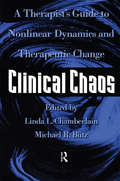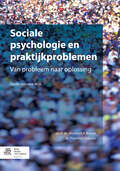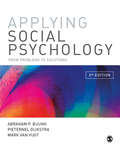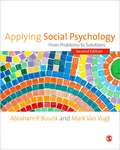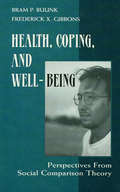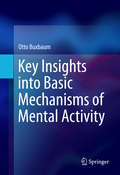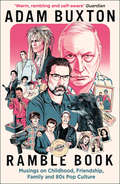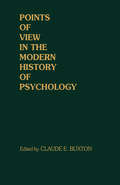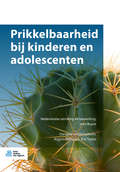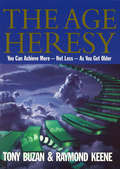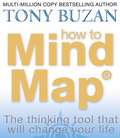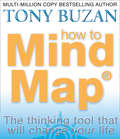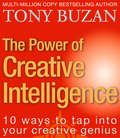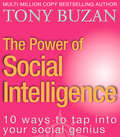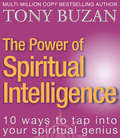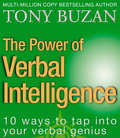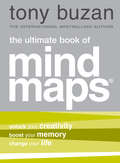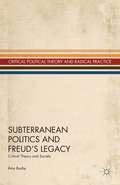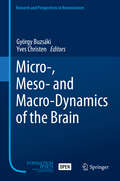- Table View
- List View
Clinical Chaos: A Therapist's Guide To Non-Linear Dynamics And Therapeutic Change
by Michael R. Butz Linda ChamberlainFirst published in 1999. Routledge is an imprint of Taylor & Francis, an informa company.
Clinical Chaos: A Therapist's Guide To Non-Linear Dynamics And Therapeutic Change
by Michael R. Bütz Linda ChamberlainFirst published in 1999. Routledge is an imprint of Taylor & Francis, an informa company.
Sociale psychologie en praktijkproblemen: Van probleem naar oplossing
by Abraham P. Buunk Pieternel DijkstraMensen stimuleren tot een gezondere levensstijl, het terugdringen van cyberpesten, en mensen weer aan het werken krijgen: zo zijn er eindeloos veel sociale en wetenschappelijke problemen die hulpverleners en beleidsmakers proberen aan te pakken. Om kans van slagen te hebben moet de effectiviteit van dergelijke interventies eerst onderzocht zijn. Juist de sociale psychologie biedt daartoe belangrijke handvatten: ze is bij uitstek het vakgebied dat helpt het gedrag van mensen te begrijpen, te verklaren en te beïnvloeden.In Sociale psychologie en praktijkproblemen wordt uitgelegd hoe professionals, op methodische en evidence-based wijze, kunnen komen tot effectieve interventies op basis van sociaalpsychologisch onderzoek en theorie. De lezer wordt door middel van opdrachten en casuïstiek uitgedaagd de kennis uit dit boek toe te passen op allerlei sociale en maatschappelijke problemen. Dit boek is bedoeld voor studenten in het hbo en wo, alsmede voor professionals die zich bezighouden met de preventie en aanpak van sociale en maatschappelijke problemen.
Applying Social Psychology: From Problems to Solutions
by Abraham P Buunk Pieternel Dijkstra Mark van VugtAre you hoping to apply what you’ve learnt in your studies to real world problems? Are you wondering how your work might make a difference? This book offers a model to ensure that your application of theoretical social psychology stands the best chance of success. Follow the PATHS model help you develop your intervention, test it, action it, and evaluate it. Each chapter focuses on a step in the model and is built around a real world example. Full of practical advice, each chapter also has an assignment to help you think through your plans and check you’ve covered all bases. Essential reading for anyone applying social psychology to real world practices and events.
Applying Social Psychology: From Problems to Solutions
by Abraham P Buunk Pieternel Dijkstra Mark van VugtAre you hoping to apply what you’ve learnt in your studies to real world problems? Are you wondering how your work might make a difference? This book offers a model to ensure that your application of theoretical social psychology stands the best chance of success. Follow the PATHS model help you develop your intervention, test it, action it, and evaluate it. Each chapter focuses on a step in the model and is built around a real world example. Full of practical advice, each chapter also has an assignment to help you think through your plans and check you’ve covered all bases. Essential reading for anyone applying social psychology to real world practices and events.
Applying Social Psychology: From Problems to Solutions
by Abraham P Buunk Pieternel Dijkstra Mark van VugtAre you hoping to apply what you’ve learnt in your studies to real world problems? Are you wondering how your work might make a difference? This book offers a model to ensure that your application of theoretical social psychology stands the best chance of success. Follow the PATHS model help you develop your intervention, test it, action it, and evaluate it. Each chapter focuses on a step in the model and is built around a real world example. Full of practical advice, each chapter also has an assignment to help you think through your plans and check you’ve covered all bases. Essential reading for anyone applying social psychology to real world practices and events.
Applying Social Psychology: from Problems to Solutions (PDF)
by Bram BuunkThe Second Edition of this best selling textbook continues to offer a simple, systematic, step-by-step guide to doing applied psychology. Using the authors' own PATH model, the text presents a new methodology for applying primarily social psychological theory to a wide range of social problems. With real-world case studies, end-of-chapter exercises and interviews with leading social psychologists, Applying Social Psychology guides students to define a problem, conduct a theory-based analysis, develop an explanatory model, set up and execute a research project to test the model, and develop an intervention. Written in the same engaging and accessible way, this Second Edition offers: A new appendix with examples of PATH model applications An extended glossary Case studies from organizational, health, and environmental psychology Recent applied social psychology research More focus on applied evolutionary psychology Social network analysis and social media as research tools. This is a highly practical text, which can be used by introductory and advanced level students who want to learn how to analyze practical problems and develop solutions based upon social psychological theory and research.
Health, Coping, and Well-being: Perspectives From Social Comparison Theory
by Bram P. Buunk Frederick X. GibbonsOver the past decades, the field of health psychology has witnessed a tremendous growth, and social psychologists have contributed substantially to the theoretical foundation of this field. Their research has focused on a wide variety of health-relevant topics such as how individuals decide to respond to threats to their health and well-being, how and why they change their behavior to avoid such threats, and especially, how they adjust to or cope with the risk of threatening disease and with the diseases themselves. As diverse as this literature may be, however, there does appear to be a common theme throughout much of it--the observation that comparison of oneself and one's health status and coping efforts with others is an integral part of the coping process. Consequently, social comparison theory is increasingly becoming recognized as a fruitful framework for illuminating health related issues. A still expanding literature is exploring the role of social comparisons with respect to coping with a wide range of health problems, including cancer, physical decline among the aged, rheumatoid arthritis, AIDS, stress at work and occupational burnout, and eating disorders. Social comparison theory has augmented knowledge about the ways in which people cope with stressful events, and thus has contributed significantly to it. At a more basic level, research in this applied context has made significant contributions to the development of social comparison theory itself. The present volume presents an overview of the various ways in which social comparison theory has been applied to issues related to health, coping, and well-being, and also points out how these applications have contributed to our insight into the way humans employ social comparison information. Given the attention paid to theoretical and applied issues, this volume will appeal to a wide audience, including social and health psychologists, as well as therapists, physicians, clinicians, medical sociologists, nurses, and those involved in the growing field of nursing research.
Health, Coping, and Well-being: Perspectives From Social Comparison Theory
by Bram P. Buunk Frederick X. Gibbons A. BuunkOver the past decades, the field of health psychology has witnessed a tremendous growth, and social psychologists have contributed substantially to the theoretical foundation of this field. Their research has focused on a wide variety of health-relevant topics such as how individuals decide to respond to threats to their health and well-being, how and why they change their behavior to avoid such threats, and especially, how they adjust to or cope with the risk of threatening disease and with the diseases themselves. As diverse as this literature may be, however, there does appear to be a common theme throughout much of it--the observation that comparison of oneself and one's health status and coping efforts with others is an integral part of the coping process. Consequently, social comparison theory is increasingly becoming recognized as a fruitful framework for illuminating health related issues. A still expanding literature is exploring the role of social comparisons with respect to coping with a wide range of health problems, including cancer, physical decline among the aged, rheumatoid arthritis, AIDS, stress at work and occupational burnout, and eating disorders. Social comparison theory has augmented knowledge about the ways in which people cope with stressful events, and thus has contributed significantly to it. At a more basic level, research in this applied context has made significant contributions to the development of social comparison theory itself. The present volume presents an overview of the various ways in which social comparison theory has been applied to issues related to health, coping, and well-being, and also points out how these applications have contributed to our insight into the way humans employ social comparison information. Given the attention paid to theoretical and applied issues, this volume will appeal to a wide audience, including social and health psychologists, as well as therapists, physicians, clinicians, medical sociologists, nurses, and those involved in the growing field of nursing research.
Key Insights into Basic Mechanisms of Mental Activity
by Otto BuxbaumA more nuanced perspective on cognition, behavior, personality, and pathology. Mind/brain.It is explained that mental activity is not possible without concepts/memory structures that exist in the brain and result from perceptual learning. Core mental activities including thinking, reasoning, and judgment are described as components of self-regulation and in terms of interacting neural systems. This framework also leads to a more specific and less stigmatizing system for classifying and diagnosing mental illnesses. This concise volume: Introduces the S-O-R (stimulus-organism-response) model of mental activity. Recasts mental processes as neuro-mental processes. Provides empirical evidence for the neural basis for judgments. Addresses ongoing mind/brain questions such as whether thinking is unconscious. Key Insights into Basic of Mental Activity will interest scientists doing research in psychology, psychiatry, psychotherapy, human biology/anthropology, linguistics, and neuroscience. Professors, lecturers, and instructors will find it important as a class text in these fields. And the book’s clinical implications make it useful to practitioners of psychology, psychiatry, and psychotherapy.
Neues Wissen über Grundfragen der Psychiatrie: Diagnose, Ätiologie, Prävention, neurowissenschaftlich fundierte Psychotherapie
by Otto BuxbaumOtto Buxbaum beschreibt Lösungen der trotz großer Fortschritte in der Psychiatrie bestehenden Grundprobleme, zu denen vor allem die Definition von psychiatrisch-psychologischen Diagnosekategorien, die Verwendung stigmatisierender Diagnosekategorien, insbesondere der Psychosen, sowie geringes Wissen über die Ursachen psychischer Störungen/Krankheiten gehören. Ein besonderes Problem für betroffene Personen (Kinder, Jugendliche, Erwachsene) sind die forensisch-psychiatrischen Begutachtungen. Denn diese Beschreibungen, Erklärungen und Vorhersagen sind in der Regel unzureichend präzise. Die Klärung der Probleme beruht auf Forschungsergebnissen über die spezifisch menschliche Selbststeuerung und Selbstkontrolle sowie ihrer neurobiologischen Grundlagen.
Ramble Book: Musings On Childhood, Friendship, Family And 80s Pop Culture
by Adam BuxtonA RADIO 4 BOOK OF THE WEEK The long-awaited, rambling, tender, and very funny memoir from Adam Buxton
Points of View in the Modern History of Psychology
by Claude E. BuxtonPoints of View in the Modern History of Psychology is a collection of papers that presents each individual contributor's expert knowledge of history in the field of psychology. One paper examines Wilhelm Wundt's concept of psychology as the propaedeutic science surviving and inspiring a generation or more of psychologists. Another paper discusses the early sources and the basic conceptions of functionalism as used in America. John B. Watson proclaims behaviorism as a new discipline in psychology with defining features, such as an objective, deterministic, scientific, and experimental method that can be used in both human and animal studies. Lieberman (1979), Mackenzie (1977) Miller, Galanter, and Pribram (1960) oppose behaviorism on the grounds that it slights the purpose of psychology, and focuses more on methodology to the detriment of theory. One paper notes that the acceptance or influence that a point of view has is based in some ways on the range and clarity of its connections with experimental and observational reality. This collection can prove useful for psychologists, behavioral scientists, psychiatrists, psycho-analysts, students of psychology, philosophy or general history who are interested in the many viewpoints of psychology.
Prikkelbaarheid bij kinderen en adolescenten
by Inez Buyck Argyris Stringaris Eric TaylorDit boek geeft handvatten voor het diagnostisch proces en de behandeling van extreme prikkelbaarheid bij kinderen en adolescenten. Het beschrijft de ontwikkeling van abnormale toestanden van woede en de gevolgen daarvan voor de latere ontwikkeling. Hiermee is het zeer nuttig voor professionals in bijvoorbeeld de geestelijke gezondheidszorg, het onderwijs en de wetenschap. Kennis over en begrip van de mechanismen die een rol spelen bij extreme vormen van woede zijn essentieel voor een goede diagnose en behandeling. Prikkelbaarheid bij kinderen en adolescenten biedt deze kennis. De inhoud is gebaseerd op recent onderzoek en bekijkt prikkelbaarheid vanuit een klinisch én wetenschappelijk perspectief. Het boek gaat bijvoorbeeld in op de onderliggende transdiagnostische factor: prikkelbaarheid komt voor bij kinderen die lijden aan verschillende stoornissen zoals autisme, ADHD en biopolaire stoornissen. Tegelijkertijd is Prikkelbaarheid bij kinderen en adolescenten een toegankelijk boek, omdat het beknopt is en het gemakkelijk leest. Prikkelbaarheid bij kinderen en adolescenten is de vertaling van Disruptive Mood, een uitgave van Oxford University Press. Het boek werd internationaal zeer lovend beoordeeld en kreeg in 2016 een eervolle vermelding in de categorie ‘Psychiatrie’ van de British Medical Association Book Awards. De auteurs van het boek zijn kinder- en jeugdpschyiaters en wetenschappers Argyris Stringaris en Eric Taylor. Inez Buyck, van de Vakgroep Experimenteel-klinische en Gezondheidspsychologie in Leuven, bewerkte en vertaalde het boek.
Allgemeine Theorie der Menschlichen Haltung und Bewegung: Als Verbindung und Gegenüberstellung von Physiologischer und Psychologischer Betrachtungsweise
by Frederik J.J. BuytendijkThe Age Heresy: How to Achieve More - Not Less - As You Get Older
by Buzan , Tony And Keene , RaymondIt is widely assumed that as we grow older there is a gradual decline in the way we use our brains. This book draws on acclaimed and proven scientific evidence to put forward a sensational brand-new theory which explodes the myth and shows that, with the right sort of mental and physical exercise, you can actually significantly improve your brain power as you get older. Drawing upon a wealth of fascinating facts and records, with studies of great geniuses such as Einstein and Goethe who improved with age, THE AGE HEARSY is packed with practical advice and guidance on how you can actively learn to enhance your memory, powers of creativity and concentration.
How To Mind Map: The Thinking Tool That Will Change Your Life (PDF)
by Tony BuzanA practical pocket guide that teaches you how to Mind Map with ease from Tony Buzan, the inventor of the Mind Map. Mind Maps® are the ultimate thinking tool for maximizing your brainpower and radically improving your performance. Mind Mapping is a revolutionary system of planning and note taking that has changed the lives of millions of people all over the world. How to Mind Map is THE definitive guide to Mind Maps brought to you by their inventor Tony Buzan. This practical pocket guide explains everything you need to know about Mind Maps and shows how they make it easy to: Get started on and plan a project • Think up brilliant ideas • Remember things • Save time.
How to Mind Map: The Thinking Tool That Will Change Your Life
by Tony BuzanA practical mini ebook guide that teaches you how to Mind Map with ease from Tony Buzan, the inventor of the Mind Map.
The Power of Creative Intelligence: 10 Ways To Tap Into Your Creative Genius
by Tony Buzan10 ways to tap into your creative genius
The Power of Social Intelligence: 10 Ways To Tap Into Your Social Genius
by Tony Buzan10 ways to tap into your social genius
The Power of Spiritual Intelligence: 10 Ways To Tap Into Your Spiritual Genius
by Tony Buzan10 ways to tap into your spiritual genius
The Power of Verbal Intelligence: 10 Ways To Tap Into Your Verbal Genius
by Tony BuzanFrom the international bestselling author Tony Buzan, simple techniques to help improve your recall and be brilliant with words.
The Ultimate Book of Mind Maps
by Tony BuzanThis book is the definitive guide to Mind Mapping. Tony Buzan has changed the lives of millions with Mind Maps, his revolutionary system of note-taking that will help you excel in every area of your life. This practical full-colour book shows how this incredible thinking tool works and how you can use it to achieve your full potential.
Subterranean Politics and Freud’s Legacy: Critical Theory and Society (Critical Political Theory and Radical Practice)
by A. BuzbySubterranean Politics and Freud's Legacy seeks to reestablish psychoanalysis as an ally to critical theory's efforts to restore subjectivity and oppose systemic domination in modernity. Given critical theory's ongoing crisis of identity and purpose, this project makes a significant contribution to contemporary political theory.
Micro-, Meso- and Macro-Dynamics of the Brain (Research and Perspectives in Neurosciences)
by György Buzsáki Yves ChristenThis book brings together leading investigators who represent various aspects of brain dynamics with the goal of presenting state-of-the-art current progress and address future developments. The individual chapters cover several fascinating facets of contemporary neuroscience from elementary computation of neurons, mesoscopic network oscillations, internally generated assembly sequences in the service of cognition, large-scale neuronal interactions within and across systems, the impact of sleep on cognition, memory, motor-sensory integration, spatial navigation, large-scale computation and consciousness. Each of these topics require appropriate levels of analyses with sufficiently high temporal and spatial resolution of neuronal activity in both local and global networks, supplemented by models and theories to explain how different levels of brain dynamics interact with each other and how the failure of such interactions results in neurologic and mental disease. While such complex questions cannot be answered exhaustively by a dozen or so chapters, this volume offers a nice synthesis of current thinking and work-in-progress on micro-, meso- and macro- dynamics of the brain.
